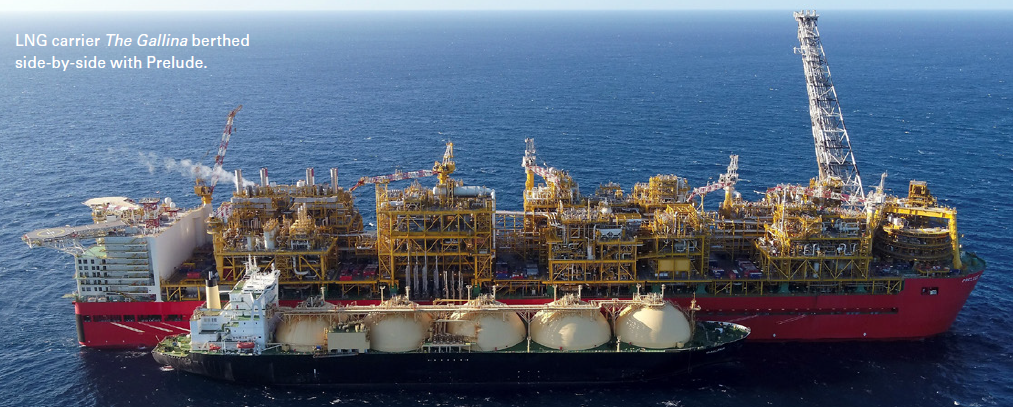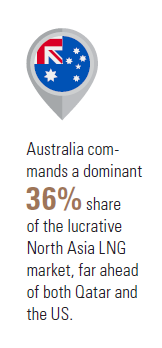Australia hit by LNG facility outages [Gas in Transition]
Two of Australia’s LNG projects – the Chevron-led Gorgon LNG and Shell’s Prelude floating LNG (FLNG) – have been hit by outages that are still ongoing. While these are expected to be relatively short-lived, they nonetheless come at a time of high demand for the super-chilled fuel, and mark the latest in a series of operational disruptions for the two facilities.
The outages are reported to have already led to the cancellation of several LNG cargoes, and could result in further cancellations depending on how long it takes for the facilities’ operators to restore service. This is potentially bad news for buyers in North Asia, who are trying to avoid high LNG spot market prices as their gas demand rises with the onset of winter.
Gorgon woes
At the 15.6mn metric ton/year Gorgon LNG terminal on Barrow Island, Western Australia, the first train was briefly shut down as a precautionary measure in mid-November following the discovery of a minor gas leak. The leak was detected on piping associated with the train’s dehydration unit.
Once repairs had been carried out and Train 1 was returned to service at the end of the month, consultancy Rystad Energy estimated that the disruption had resulted in the loss of two cargoes from Gorgon. However, once Train 1 was returned to service, Train 3 was then taken offline December 1 in a controlled shutdown to allow Chevron and its partners to address a similar issue affecting the train’s dehydration unit.
As of mid-December, Train 3 remained offline. This is the latest in a series of operational challenges for Gorgon, which began producing LNG in 2016. Prior to the latest outage, each train in turn had been taken offline for inspection and repairs since the middle of 2020 after weld quality issues were found to be affecting propane heat exchangers.
Train 3 was the last of Gorgon’s trains to be shut down for inspection related to that issue, returning to service in mid-2021. Since then, the project has also come under fire over the underperformance of its carbon capture and storage (CCS) facility, which is supposed to capture up to 4mn mt/yr of CO2 from Gorgon. Indeed, a condition of Gorgon’s approval by Western Australia’s state government had been that at least 80% of its CO2 emissions stemming from the upstream portion of the project would be captured for storage.
However, the CCS facility encountered delays during construction, only starting up in August 2019. As a result of these delays, by the end of the five-year period that ended in July 2021, it had only captured and stored around 5mn mt of emissions from Gorgon, falling short of the 80% target by roughly 7.4mn mt.
While Chevron is taking steps to address the carbon capture shortfall at Gorgon, the failure to meet the target had come as another setback for the project. Now, the latest outage at Gorgon Train 3 poses a further challenge for Chevron and its partners in Gorgon – ExxonMobil, Shell, Osaka Gas, Tokyo Gas and JERA.
“Gorgon has certainly been prone to operational issues, probably reflecting inadequacies in the initial planning,” advisory firm EnergyQuest’s CEO, Graeme Bethune, tells NGW. “Wheatstone has done better,” he added, referring to another Chevron-operated project in Western Australia that has been exporting LNG since 2017.
Prelude problems
Separately, Shell is battling a new setback at Prelude, which is the world’s largest FLNG project, with a capacity of 3.6mn mt/yr.
Production at the facility, offshore Western Australia, was suspended after a small fire broke out on December 2. While the fire was quickly contained by automatic fire detection and management systems aboard the vessel, it was followed by a power outage. This caused operations to be paused and many of Prelude’s staff to be evacuated, with only a skeleton crew remaining aboard the facility.
Like Gorgon, Prelude has struggled with a series of operational issues. The vessel spent around 11 months offline following an electrical trip in February 2020. It returned to service in January 2021 and had six months of uninterrupted production until the latest incident.
However, EnergyQuest noted in its latest Australian LNG Monthly report that supply to Prelude had been reduced from late October owing to production failures from the fields supplying gas to the facility.
“I think it is more that this is a completely new concept, so prone to technical issues,” Bethune said of Prelude.
Indeed, the project, which is moored 400 km offshore, had been aimed at unlocking remote gas fields that would not otherwise be developed, but its operational struggles have led to questions over the use of the FLNG concept. Prelude’s experience may deter other LNG developers from pursuing similar types of projects, while onshore facilities may look more attractive in comparison.
“FLNG appears to be off the agenda now,” Bethune said. “I think smaller and less complex is certainly the way things are going.”
Market dominance
The outages at Gorgon and Prelude threaten to exacerbate an already tight LNG market as buyers of the fuel in North Asia and elsewhere step up winter purchases. Rystad estimated on December 8 that the shutdowns at both liquefaction plants could result in the loss of up to six cargoes over the course of the month. And the outages could well run beyond December, causing further disruption. Neither Chevron nor Shell have provided a timeframe for restoring their facilities to service. As of December 9, it was reported that three Prelude cargoes had been cancelled.
 Bethune said he expected the outages at both terminals to be temporary. Nonetheless, the incidents illustrate the challenges involved in operating the larger, more complex LNG projects, and come at a difficult time for the market, when buyers are trying to avoid spot purchases of LNG owing to high prices.
Bethune said he expected the outages at both terminals to be temporary. Nonetheless, the incidents illustrate the challenges involved in operating the larger, more complex LNG projects, and come at a difficult time for the market, when buyers are trying to avoid spot purchases of LNG owing to high prices.
Prior to the outages, Australia’s LNG trade had been booming, despite trade tensions with China – one of its major buyers. EnergyQuest estimates that total annualised Australian LNG exports for November reached a record 87.0mn mt/yr, with around 102 cargoes delivered from liquefaction terminals in the country over the course of the month.
The advisory firm noted that Australia remains “far and away” the largest supplier of LNG to North Asia, with an aggregate market share of 36% across China, Japan, South Korea and Taiwan in October. At the same time, Qatar had only a 14% share across those markets, and the US – the farthest from the most lucrative LNG markets in the world – had but 11%.
These trends bode well for the newly sanctioned Pluto LNG expansion project, which Australia’s Woodside approved in November, along with the Scarborough offshore gas development that will supply a second train at Pluto. However, EnergyQuest noted in its monthly report that Scarborough was still only 60% contracted, despite the project being an “obvious” candidate for Chinese contracts in the current market.
A heads of agreement (HoA) that was signed with China’s ENN Natural Gas in 2019 does exist, but it is non-binding and a firm contract has not yet materialised. Additionally, ENN appears to have since turned its attention elsewhere, signing a sales and purchase agreement (SPA) with Cheniere Energy in the US in October this year.
EnergyQuest did not rule out the possibility that a contract announcement for Pluto Train 2 could be imminent, but warned that Australia’s dominance in the Chinese LNG market would be under threat if no more offtake agreements are signed.



